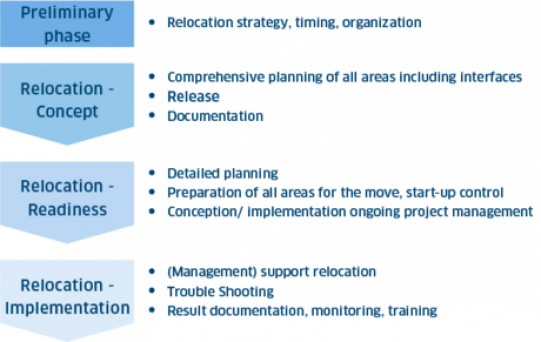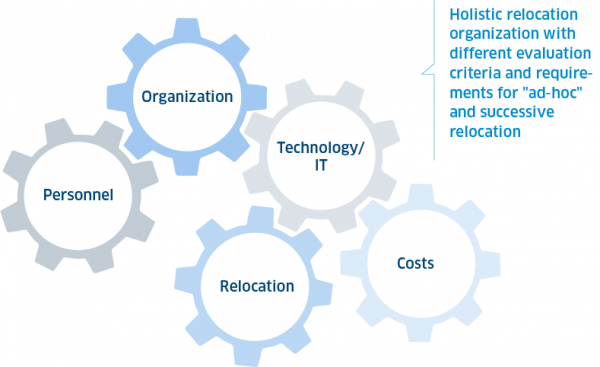

31.05.2023 | Written by Ole Grasedyck, Miebach Consulting
Management of logistical moves
When planning and realizing logistics centers, including intralogistics and IT, sooner or later the question arises of how to relocate the goods and associated perimeters (personnel, infrastructure, etc.) from the existing site structure. In this context, one is well advised to plan this move from the very beginning in the realization of large-scale supply chain engineering projects.
The management of logistical moves includes the following objectives:
Procedure Model

Fig. 1: Miebach's process model for moving logistics systems
Preliminary Phase
Planning logistical moves - start early!
Experience shows that the planning of logistical moves is often procrastinated, as moves are only scheduled at a late stage of the overall project. This can later prove to be a major risk, as logistical moves are complex projects that involve long lead times at many interfaces (for example, supplier orders with long delivery times, contracts with long terms that have to be terminated in good time, etc.).
A distinction must be made between pure relocation planning and startup management. In the case of start-up management, the interfaces to the stores and customers, as well as to the suppliers, are planned and implemented more precisely.
Relocation Concept
Figures, data, facts - structure of planning basis
When setting up the planning basis, all relevant information required for the relocation planning is collected. It is made clear which sub-processes and which product groups/types or brands exist at which location. For personnel planning, the number of employees required for each sub-process should be determined for the period from go-live, as the exact onboarding times need to be defined in connection with the move. A (rough) quantity structure with the most important planning parameters such as inventory, throughput, article structure, etc. should be included for the material groups/types. An overview of all contracts with the contract terms and termination dates is just as necessary as an early determination of deconstruction requirements at the existing locations.
Organize
Organizing the move - involving those responsible
It is essential to select and involve relevant relocation stakeholders and managers at an early stage."
A relocation project organization chart should be drafted and filled with the key employees involved in the relocation. The future site manager needs to be involved in the relocation project as early as possible. Ideally, the logistics relocation is included in the project organization as a separate sub-project alongside construction, IT, intralogistics, and start-up with corresponding responsibilities. A meeting structure with the definition and initiation of regular communication and jour fixes is also necessary, since in addition to the relocation planning there is a great need for communication and information as well as control of deadlines and tasks for the work packages. The regular and early involvement of logistics, IT, purchasing, and other departments is important.

Fig. 3: Evaluation criteria of the relocation strategy
Each sub-process and scope...
Each sub-process and scope is evaluated in particular with regard to complexity and risks. Together with other parameters (personnel, contracts, etc.), the order of the scopes to be moved is determined. Certain areas can be moved ad hoc and other scopes successively, resulting in a strategic overall picture in which both risk minimization on the one hand and cost-effectiveness on the other are weighed up.
Relocation scheduling
An important management tool
The sequence of sub-processes or locations to be relocated, as defined in the relocation strategy, is then transferred to the relocation schedule. It is important to consider whether there should be further clustering. For example, certain sub-process clusters can be defined in terms of suppliers, which are relocated in stages, or customers or branches, which are connected to the new delivery location in stages. In principle, a sub-process should be relocated during a delivery-free period, for example on the weekend. Ideally, deliveries from the old site to customers or branches should then be stopped on Friday, before all systems and areas are set up at the new site over the weekend so that deliveries from the new site can begin on the following Monday. The next partial move should take place with a time delay, for example, two weeks later, so that the volume which has been moved so far can be stabilized in day-to-day business
As a rule, new processes are implemented operationally with each move and the employees involved initially need a learning phase."
In the later detailed planning, the relocation schedule includes the exact implementation date. Initial planning of all preparatory activities and activities to be carried out, including milestone tracking, is initiated and continuously refined during the preparation for the move. Standardized checklists for the relocation of the logistics systems are also derived from the relocation time planning and later used in the relocation preparation.
Personnel planning
Getting the right employees on board at the right time
In the course of personnel planning, rough planning is carried out for both the relocation and the start-up. This involves regular coordination with site management and HR. The times for the start of recruiting, for onboarding, for the implementation of training, and for the start of productive work by the employees must also be included in the relocation schedule. In this context, it is also important to clarify how much staff can be transferred from old locations. In addition, it must be taken into account that personnel may still have to be available at the old site for a certain period of time to maintain operational readiness.
Procurement planning
Freight in particular must be organized
The procurement planning determines what material is needed for the move. This includes packaging, loading aids, foiling, etc. The transport can be carried out by external companies or with their own transport capacities, if available. It must also be determined which furniture and other equipment will be moved from the old location and what will happen to the remaining equipment at the old location (sale, scrapping, dismantling, etc.). Another important aspect is that, due to a possible parallel operation, additional freight will be required for cross transports and additional transports. The route plan from the new site also needs to be clarified.
Have clarity on contracts early on
It is essential that contract monitoring is installed at an early stage. All relevant contracts that need to be terminated should be archived centrally and checked in detail with regard to termination conditions and dates. A central overview of all contracts and the termination dates is important for the relocation plan, additionally to the rental contracts for the buildings this should also include all other contracts, such as cleaning services, canteen operations, waste disposal, etc.
Establish risk management,
report regularly, and escalate as needed
The risk management system is part of the logistical relocation planning. Based on the results of the risk analysis, an emergency concept, as well as an escalation and communication matrix are installed.
Readiness
Detailed planning and preparation of logistical moves - be well prepared!
In the course of the detailed planning, the time, quantity, and personnel planning has to bethorough. In addition, relocation controlling needs to be implemented. This involves status controlling in accordance with the relocation schedule and checklists and, if necessary, escalation management in the event of critical milestone deviations. In connection with material procurement and operational set-up, new logistics areas and workplaces are set up and marked and the necessary equipment is procured and prepared.
Staff recruitment and onboarding focuses on recruiting and onboarding staff in coordination with HR and site management. The training/instruction of the (possibly new) employees should be handled via a separate sub-project due to its complexity, among other things. Preparing the IT systems includes, among others, ensuring IT equipment availability and setting IT parameters.
The detailed planning of the start-up control is based on the fact that the interfaces to the suppliers and customers or branches have been finally clarified and the emergency concept including escalation and communication matrix is available.
Implementation
Implementation of the physical move - ensure smooth moves!
During the management of the physical move, the permanent control and monitoring of the loading, transport, unloading, and set-up on site takes place. Logging of the transfer of part numbers and equipment should take place or inventory should be taken as needed. Here it is important to start with “clean” inventory at the new location. Additional staff need to be provided for trouble shooting activities and support. The informational move is accompanied by IT experts or a hypercare team. As part of the implementation, start-up control, monitoring of the supplier and customer or store changeover, on-site support, if required, and hotline support will be provided.
Conclusion
We, as Miebach Consulting, see great benefits in designing and implementing a logistics relocation management plan for supply chain engineering in large-scale implementation projects. With this target-oriented management of the logistical move, both administrative and management-related gaps in this area are closed.Ensure your implementation success in logistical moves!
Are you about to launch a major relocation project or do you have any questions or comments on this subject? Do not hesitate and feel free to contact us!
Author
